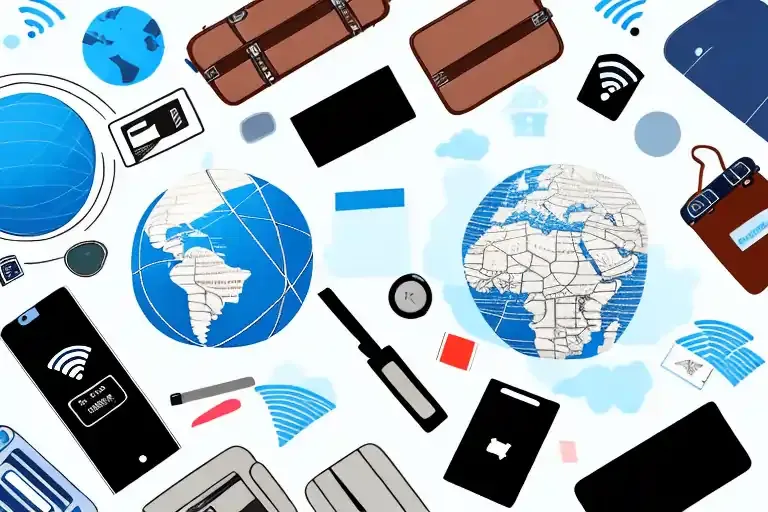eSIM
Best Ways to Stay Connected when Traveling
5 ways to get Internet when traveling
In the age of constant connectivity, staying connected while traveling has become more of a necessity than a luxury. Whether you're a digital nomad, a frequent business traveler, or just someone who wants to share their adventures with loved ones, having reliable internet access on the go is crucial. In this blog, we'll explore some of the best ways to get internet while traveling, the pros and cons of each option, and which is best for you.
1. Data Roaming
Pros: Convenient
Cons: Usually very expensive
One of the most convenient ways to staying connected as you travel will be to turn on data roaming. If data roaming is already activated on your primary line, all you need to do is to turn on data roaming on your phone. That's it!
But, this convenience doesn't come cheap. Data roaming costs can very quickly amount to a very large cost - especially if you are paying as you roam.
Some mobile carriers offer data roaming passes that provide a set amount of data for a fixed price in specific regions; and some carriers offer international data packages that allow you to use your existing plan in different countries. These options are often more cost-effective than if you were to pay as you roam, but costs could still remain high.
It is recommended that you check with your mobile carrier on the possible options before you roam!
2. Local SIM cards
Pros: Usually cost-effective, local phone number
Cons: Inconvenient, not always the most cost-effective
One of the most popular ways to access the internet while traveling is to purchase a local SIM card. Local SIM cards also often come with a local number, which is a big draw factor for many travelers who think they might need a local number for calls and other purposes.
Purchasing a local SIM card is also generally believed to be the most cost-effective and reliable, as you will be tapping into the local network directly. However, it is important to note that this might not always be the case.
There may be some destinations where purchasing a local SIM card could be more expensive than other options - and prices are not always the most transparent if the SIM cards are sold primarily through third-party retailers instead of direct sales from the telcos.
If you are planning to get a local SIM card, it is recommended that you get a SIM card from a reliable source, and to check out the prices of the tourist or prepaid plans that are offered by local telcos before your trip.
Getting a local SIM card with a local number often requires that you provide a proof of identity - and in most cases, you will only be able to get the SIM card at the local counters at the airport, which could be quite a hassle if you are rushing to get out of the airport.
3. Portable WiFi Devices
Pros: Good for groups that will be traveling together
Cons: Extra device to carry around
Portable Wi-Fi devices, also known as pocket Wi-Fi or Mi-Fi devices, are compact gadgets that create a personal Wi-Fi hotspot wherever you go. They often support multiple devices, making them an excellent option for group travelers or those with multiple devices. Many companies offer rental services, allowing you to pick up and drop off the device at your destination.
Portable WiFi devices were popular back in the day before smartphones supported dual-SIM capabilities, and travelers want to keep their primary SIM active while also staying connected. But today, with dual-SIM capabilities, it is possible for you to keep your primary SIM active while having a secondary SIM card in your device that provides you with connectivity, which makes portable WiFi devices much less attractive.
Portable Wi-Fi devices can be expensive if you are traveling solo, but if you will be traveling in groups (and will be sticking together most of the time), this is often a good option as you can share the cost.
However, using a portable WiFi device also means you will have to carry around an additional device, and that is one more thing that you will need to charge to ensure that the device doesn't run out of battery in the middle of the day.
4. Travel eSIMs
Pros: Convenient, cost-effective
Cons: Not all phones support eSIMs
In recent years, travel eSIMs have been rising in popularity as an option for staying connected when traveling. There are many providers of travel eSIMs offering international eSIMs in many destinations globally.
Often, these travel providers offer eSIMs at near-local rates — and can sometimes even be cheaper than if you were to get a local SIM card.
Cost-aside, one of the biggest advantages of travel eSIMs is the convenience that it brings. Simply purchase a travel eSIM for your destination ahead of your trip, install it on your phone (usually by scanning a QR code), and activate it right before your trip! Skip the queues at the airport and any KYC checks, and skip fumbling with your physical SIM card or additional devices.
However, it is important to note that not all phones support eSIMs. It is important to check that your phone is eSIM-compatible before purchasing one.
Perhaps also good to note is that travel eSIMs are international eSIMs and your internet traffic could be routed via a different country. This could result in some latency if the traffic is routed via a country that is geographically very far from your location; but otherwise, any impact to performance is barely noticeable.
If it is your first go at a travel eSIM, spend some time reading through reviews to help you decide which eSIM to go for. If you are overwhelmed by the number of choices, Nomad is one of the best options for travel eSIMs, with competitive prices and good global coverage.
5. Public WiFi networks
Pros: Free
Cons: Not always available, security risks
If you don't need to constantly stay connected when traveling, an option that you can consider will be to simply tap on public WiFi networks.
In major cities, you will typically be able to find public WiFi networks in airports, hotels, cafes, and other public spaces. However, this is not always the case, and the availability of public WiFi could vary from city to city.
Public WiFi networks are typically free, but some of them could have a time limit imposed on it. Public WiFi network could also come with security risks, since the network can be shared by many people, including bad actors.
While free, public WiFi networks are not the most convenient, nor are they always reliable. Relying solely on public WiFi networks to stay connected should be considered only if do not always need to be connected when you travel.
It is also recommended that you download your maps and other useful resources that you might need while traveling, in case you do not find a public WiFi network that you can connect to.



